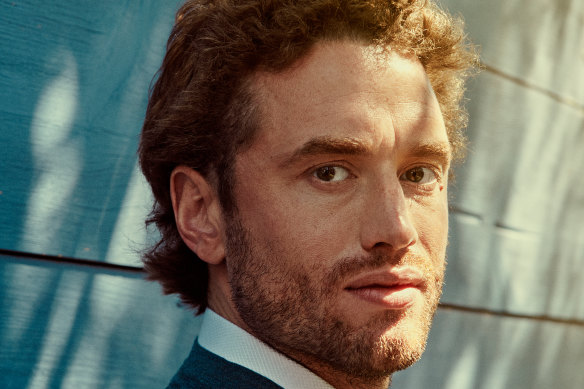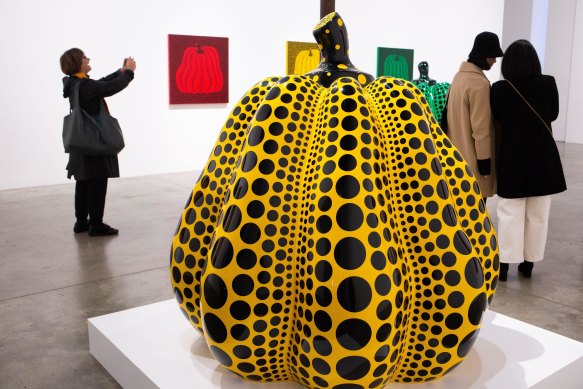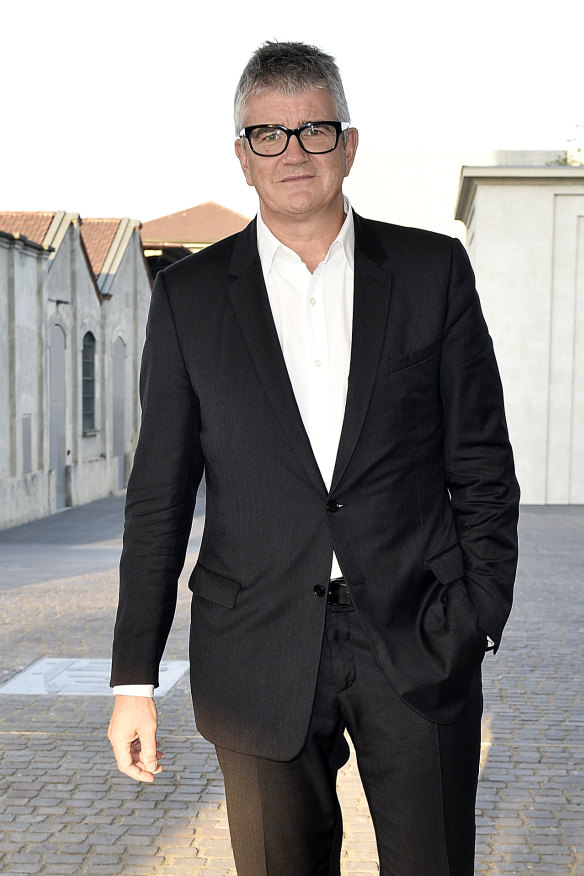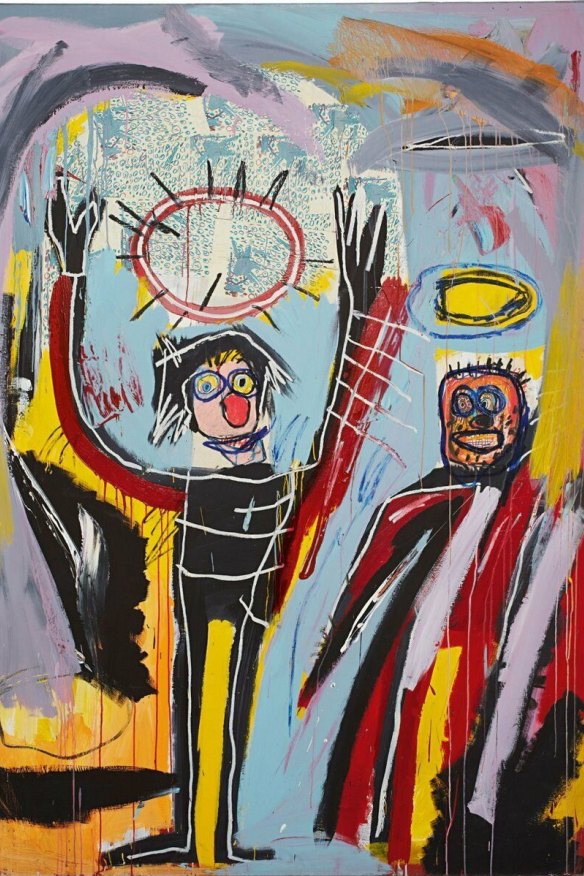This was published 5 months ago
Private jets, Ibiza villas and $9000 wines: An epic art fraudster tells all
Inigo Philbrick went to jail for the largest art fraud in US history. But he isn’t losing too much sleep over those he defrauded.
By Laura Pullman

Philbrick was sentenced to seven years’ jail but was released in March. He was sent Country Life magazines in prison, which proved a hit with the Colombian cocaine kingpins: “They’d be tearing pages out and sending them to their architects.”Credit: Guerin Blask/The Sunday Times Magazine
On a lazy afternoon in June 2020, in the Pacific island country of Vanuatu, Inigo Philbrick was at a market in Port Vila with his fiancée, British reality TV star Victoria Baker-Harber, of Made in Chelsea fame. They had just had lunch and were seeking out a particularly delicious green-tea-flavoured cake when a team of flak-jacketed heavies swooped in. “Are you Inigo Philbrick?” they barked before arresting him.
The US federal agents had flown thousands of miles to nab the art world’s most infamous wunderkind-turned-fraudster. Philbrick, a London-born postwar and contemporary art dealer, had swindled friends, collectors and investors to the tune of $US86 million (about $129 million) before defaulting on debts and mysteriously vanishing in 2019 from the galleries he ran in London and Miami.
Now the jig was up. As Philbrick was handcuffed with zip-ties, Baker-Harber, who was five-and-a-half months pregnant with the couple’s daughter, Gaia, at the time, screamed. Philbrick was driven to Port Vila International Airport, hauled onto a Gulfstream V jet and flown to America to face the music for what the FBI called the largest known art-based fraud in US history.
In court in New York, the young art dealer was accused of defrauding wealthy clients by selling and reselling shares in the same highly prized art to multiple investors, and securing loans by using artworks as collateral without the knowledge of co-owners. He forged documents and even made up a fake investor.
Philbrick, now 37, pleaded guilty and, in May 2022, almost two years after that dramatic arrest, he was sentenced to seven years in prison. He was released in March this year to home detention and reunited with Baker-Harber, 35, and Gaia, 3.
I meet them in a Great Gatsby-esque corner of New England stuffed with 18th-century clapboard houses, fudge shops and antique stores, where they are temporarily living on the coast (they ask me to be vague about exactly where). This doesn’t mean he has to stay at home all the time. During our interview we bounce from a bakery to a shopping centre to an Italian restaurant, on a strict timetable that Philbrick has agreed with the Federal Bureau of Prisons.
He doesn’t appear to be wrestling with any burdensome guilt. “There are a lot of people who look at it and say, ‘Look, I didn’t kill anyone, I didn’t do anything violent in any sort of way,’ ” he says. “Beyond that, the people who are involved in my case – no one missed a meal, nobody didn’t send their children to university. I don’t think that anyone in this whole story is guilty of much more than greed and ambition,” he says in his soft, suave east-coast accent.

US federal agents arrest Philbrick in Port Vila, Vanuatu in 2020. “I would have come to New York under my own steam,” he says now.
If his self-confidence has taken a knock in recent years, he isn’t letting it show. “I don’t think any good business happens without ambition and I think greed is a natural human state. I’d feel a lot more guilt if I had been drink-driving or if I’d been selling drugs and someone had died.”
Dressed in navy chinos and green suede shoes, he has a Peppa Pig plaster on his finger. “I’m very happy to sit with Gaia and talk about what I did and why,” he says. “And then there’s a lot to be learnt about being upfront and transparent, about ambition and how it can be a double-edged sword. Those are actually really healthy, good conversations to have with her and I wish someone had had them with me [when I was younger].”
The tale of the rise and fall of Inigo Philbrick, which seems part Catch Me If You Can, part The Thomas Crown Affair, is an extraordinary one that shines a light on the soft underbelly of the art world, where deals can be murky, ethics are sometimes questionable, barolo is free-flowing and party drugs are there for the taking. This is the glamorous orbit where bright young things vie to offer unique investment opportunities to the global super-rich as they whirl between Art Basel Miami, Frieze London and the Venice Biennale.
‘I don’t think any good business happens without ambition and I think greed is a natural human state.’
Inigo Philbrick
“We’re dealing with a lot of people who have real generational wealth,” Philbrick says. To these clients it’s “Monopoly money”, adds Baker-Harber, who says her own pantomime-villain image on Made in Chelsea, the reality TV show, was partly an act. “You have to play up to being a sassy bitch or whatever. I can be sassy for sure, but this idea that I’m a snob that looks down on people? I’m not,” she says.
To interview Philbrick and Baker-Harber is to enter a tornado of mind-boggling anecdotes and head-scratching finances. We meet the day before their wedding, a quickie ceremony without guests, in part to help secure an American visa for Baker-Harber, who is half-British, half-Australian. They suggest we supply bridal wear for our photo shoot. We decline.
“I have a little off-white jacket I could wear and he’s got some trousers that cover his ankle bracelet,” she says, smirking. They plan to have a “low-key” event for family and friends in June, when the electronic ankle tag is due to come off. “Not the wedding that I’ve pictured since I was nine,” adds Baker-Harber, who counts Donald Trump’s younger daughter, Tiffany, among her high-society friends.

Philbrick with his British-Australian wife, Victoria Baker-Harber, and daughter Gaia, 3. “I’m very happy to sit with Gaia and talk about what I did and why,” he says.Credit: Guerin Blask/The Sunday Times Magazine
Inigo Philbrick’s ascent in the art world was dizzyingly swift. Born in Hackney, east London, while his parents were briefly in Britain, he was named after the 17th-century English architect Inigo Jones. He was raised in Redding, Connecticut. His father, Harry, a curator, was the director of the Aldrich Contemporary Art Museum and later the Pennsylvania Academy of the Fine Arts. His mother, Jane, is an artist and writer. “We were in the true American upper-middle class, in that we had two cars,” he says. But his parents divorced and shortly afterwards, at the age of 19, Inigo moved to study at Goldsmiths, University of London, and take up work experience at the White Cube gallery in Shoreditch, where the founder, Jay Jopling, had fostered the careers of Tracey Emin, Damien Hirst and the other YBAs (young British artists) of the 1990s.
Jopling quickly found a protégé in Philbrick, whose chutzpah and ability to talent-spot investable artists was immediately evident. “I always had opinions about what art mattered and what art didn’t matter,” Philbrick says, sipping a double espresso. “There are relatively few people in the art world who really take a position.”
By the time he was 24, in 2011, he had opened a gallery, Modern Collections, in Mayfair, with Jopling, who could be, Philbrick says, impossible to please. “Jay is the kind of person who’s never happy. You could do a deal and make $5 million and he would go, ‘Well, it’s not six [million].’ ” Nevertheless, the young buck kept soaring. Modern Collections later became the Inigo Philbrick Gallery and, in 2018, he opened a second space in Miami. At the start he sold pumpkin sculptures by the Japanese artist Yayoi Kusama, canvases by Christopher Wool, an American artist known for his large black stencilled letters, and work by the Italian-born conceptual artist Rudolf Stingel. He called himself “Stingeldamus”, a riff on Nostradamus, for his ability to foretell the market.
Self-assured and silver-tongued, Philbrick was living a life of private jets, $9000 bottles of wine, Ibiza villas and ski chalets in the Alps. He wore a $90,000 watch, $9000 suits from Milan and had an account at the Cipriani restaurant in Mayfair – so that he didn’t have to do anything as déclassé as produce a credit card at the end of a blow-out lunch with clients.

Philbrick sold pumpkin sculptures by Yayoi Kusama at his Mayfair and Miami galleries.Credit: Alamy
Was he faking it to make it? “In that regard, I wasn’t faking it. The faking it came later,” he says, claiming that he was initially making enough to fund his jet-set existence. Now he is keen to play down his expensive tastes. “We will drink really cheap wine if that’s all there is,” he quips.
He also had the statuesque Baker-Harber on his arm. The pair had met in 2016 on a friend’s yacht in the Mediterranean. Philbrick was with his Argentinian girlfriend, Francisca Mancini, who was pregnant with his child at the time – but he immediately became “completely obsessed” with straight-shooting Baker-Harber. She had grown up in Belgravia, London, the daughter of the late Michael Baker-Harber, an Olympic sailor turned lawyer, and Anna, an Australian interior decorator, had attended boarding school and spent summers in St Tropez and Mykonos. Baker-Harber says Philbrick wasn’t her type –“I just always liked them a little darker” – but by late 2017, she was wooed. (Philbrick today has no relationship with Mancini or his elder daughter.)
In Philbrick’s telling, his problems largely began when Robert Newland, a British art insider who had also worked for Jopling, started acting as his financial adviser in 2012. “I was tremendously successful and my mistake was listening to a guy who told me I could be that and more,” he says. “That’s an
innocent mistake followed by mistakes that were not innocent.” (Last September, a New York court gave Newland a 20-month prison sentence after he pleaded guilty to one count of conspiracy to commit wire fraud. Newland’s lawyer has previously pointed to Philbrick’s lengthier sentence as evidence that his client was not the ringleader.)
Prosecutors set out that the criminal operation ran from 2016 to 2019. Works caught up in the scheming included Humidity, a 1982 painting by Jean-Michel Basquiat, a portrait of Pablo Picasso by Stingel, and the painting Untitled (2010) by Wool. In one case, Philbrick sold a Kusama Infinity Mirror Room in 2019 but didn’t tell the owners (who had hoped that Philbrick would sell it at a profit) or pay them for it.
In another case he owed money to Jopling, who had helped him buy artwork that Philbrick claimed to have sold on. Rather than confessing that he had not actually made a sale, he invented a fictitious buyer – an Argentinian financier, Martin Herrero. He emailed Jopling, posing as Herrero, to buy himself time on the debt. In 2019, an artwork Philbrick had been involved in acquiring and reselling was sold at auction for $US5.5 million (about $8.2 million), but that unravelled when multiple people claiming ownership came forward seeking their slice of the pie. By now, civil lawsuits against Philbrick had mounted and angry investors were out for blood.
Philbrick has “zero” regret about creating the fake financier, claiming that the use of false names is something that happens in the industry. “The idea that that is in any way my particular wicked invention is absolutely nonsense,” he says. “Straight from the playbook,” Baker-Harber adds. He does concede, however, that forging a sales contract from Christie’s was the “stupidest thing I ever did, which will be forever something that I can’t escape”.

London gallery owner Jay Jopling took Philbrick under his wing, but fell victim to the art fraud scheme.Credit: Getty Images
In October 2019, Philbrick abandoned his galleries and suggested to Baker-Harber that they disappear for a while. “There’s no way I was going to get up and let him go through whatever shit was going to come his way on his own. I just wouldn’t do that,” she says. “He’s the love of my life.” Although she had watched her love getting visibly more stressed, she says she was unaware of his house-of-cards finances.
That month the couple flew (economy) to Australia, planning to stay with Baker-Harber’s grandmother in NSW, but that plan was kiboshed thanks to bushfires. Instead they headed to Vanuatu, a luscious island with a reputation as a sunny paradise for shady people. “It was a pretty demoralising time, to be honest. To have everything you’ve built ...” Philbrick says, trailing off. Nevertheless they enjoyed a three-week trip to Japan, where they travelled by bullet train, drank saké, took a pottery class – and discovered that Baker-Harber was pregnant.
Back in Vanuatu, as the pandemic hit, the pair spent their days having tennis lessons, hiking and looking after their rescue dog, Bacchus. “It never in a million years occurred to me that I would be said to be on the run,” Philbrick says, adding that he was travelling on his own passport and using his real name. “If I wanted to hide and was trying to not get extradited, we’d have gone to Russia, we’d have gone to Iran.”
On June 12, 2020, the federal agents pounced. “If they wanted to talk to me, I would have come to New York under my own steam,” he says. He recalls thinking, “What a strange platform they’re giving me by making this big public scene,” as he sat on the Gulfstream V in his espadrilles and swimming shorts. (Baker-Harber is keen to clarify that the shorts were not designer, as has previously been reported, but “literally bought in a flea market” in Naples.)
He was flown from Vanuatu to Guam, a US island in the Pacific, where he was strip-searched and locked up in prison. There were further jail stops in Hawaii, Los Angeles, Nevada and Oklahoma. He says he spent the whole time fretting, not over the legal battle ahead, but about his pregnant fiancée – “my life, my heart, my worry, was all with Victoria in Vanuatu”.
“It’s a miracle I didn’t lose the baby because my stomach was just turned inside-out,” Baker-Harber adds. “I couldn’t eat, I couldn’t sleep.”
While she returned to her mother’s house near Hyde Park in London, Philbrick’s new home was the Metropolitan Detention Centre, a notoriously grim jail in Brooklyn, New York, where Ghislaine Maxwell has spent time. “It’s a very strange thing when you get arrested if you’ve never thought about prison life. Literally my conception of prison was The Shawshank Redemption,” he says, referencing the 1994 film. “They love watching that in prison.”
For a year he shared a cell with Nicholas Tartaglione, a former police officer jailed for killing four men, who had been Jeffrey Epstein’s cellmate when the paedophile financier first attempted suicide in July 2019. (Epstein died in jail the following month.) “Nick [Tartaglione] is like family, Nick’s amazing,” Philbrick says. He was also locked up alongside Keith Raniere, the leader of the Nxivm sex cult whose “slaves” were branded with his initials. He recalls Raniere’s followers gathering outside the jail walls each evening to send signals to their leader using torches.

Humidity (1982) by Jean-Michel Basquiat was caught up in the art fraud.Credit: Jean-Michel Basquiat, Humidity (1982). Acrylic, oilstick, and Xerox collage on canvas. Courtesy Phillips.
Over lunch, Philbrick lifts his shirt to show me a fuzzy tattoo of a “V”, for Victoria, on his chest, which he had done by a fellow inmate named “Face” (who had his nickname tattooed across his forehead). “It really sounds silly but there were moments where we would go a month, a month-and-a-half, without me being able to call Victoria and [the tattoo] was actually really symbolic and important.”
The thing he says he will never forget is “just how casual the violence is. I saw stabbings, officers assaulted by inmates, inmates assaulted by officers.” He says he only got into one scrap – with a “young Blood gang member” over the use of a telephone; Philbrick ended up thwacking his opponent over the head with the phone. “It’s one of those environments where if you don’t stand up for yourself, you don’t get.”
While inside, Baker-Harber’s mother, Anna, sent him copies of Country Life magazine, which were apparently popular with the Colombian cocaine kingpins. “They are building these mansions back home in Colombia – they’d be tearing pages out and sending them to their architects,” Philbrick says.
Unsurprisingly, as soon as Philbrick was locked up, people claiming to have signed deals with Netflix or Hulu wrote to him, trying to secure his story in his own words. “In general they don’t really have the funding they’re telling you they have, which quite reminds me of the art world,” he says.
In 2020, an art dealer named Kenny Schachter wrote a piece in New York Magazine that detailed how he’d lost $US1.75 million (about $2.6 million) thanks to his old friend Philbrick who, he added, enjoyed the company of prostitutes.
“Everyone was happy to dance while the music was playing,” Philbrick says when I raise this. “T-shirts were literally made that said, ‘Where’s my money?’ and sent among other guys who were clients of mine – the joke being maybe Inigo is giving your money to him or to her. Everyone knew that things were being financed on a kite-string. That doesn’t excuse me, but that’s a big part of the story.”
On his erstwhile taste for prostitutes, he says, blushing, “That is much more common in the circles that we move in than we would normally see represented in the press.”
Adjusting to family life, the couple are writing a book about their experiences as inmate and loyal moll, have worked on a BBC documentary, which comes out this year, and are not against their saga getting the Hollywood treatment. “It is a love-conquers-all story,” says Baker-Harber, who wants to be played by Margot Robbie “in an ideal world”. Timothée Chalamet could be the wheeler-dealer anti-hero, I suggest. “Mm-hm, he’d have the range,” Philbrick agrees.
‘Have I slept with hookers? Yes. Have I taken drugs? Yes. Did I used to drink a lot? Yes.’
Inigo Philbrick
With the $US86 million he owes in restitution hanging over him, Philbrick must pay 15 per cent of his monthly income to the government once he’s fully free and back to work. He says the $US86 million figure cannot be accurate – partly because the value of certain paintings caught up in the scam cannot be known until they are sold – but says his lawyer advised him to go along with that figure to avoid being accused of wasting government time.
Baker-Harber repeatedly stresses that Philbrick doesn’t have $US86 million stashed away “in a cupboard”, as some people apparently think. Indeed, she and her family have been financially supporting him. The couple also dismiss the idea that Philbrick had a problem with drugs. “Have I slept with hookers? Yes. Have I taken drugs? Yes. Did I used to drink a lot? Yes,” he says, growing exasperated. “Are any of those things defining parts of my story? I don’t think so.”
He remains hopeful about returning to his old industry. “Once you’re in, you’re never really out,” he says, finishing his chicken Milanese. “That’s why I think there probably is a second act for me in that space. What does that look like? I don’t know.”
Right now, though, lunch is over and the pair must go to collect their marriage licence ahead of their low-key big day. “I’m so glad that I persevered and that I’m here,” Baker-Harber says, stroking Philbrick’s temple. “For richer, for poorer.”
This is an edited extract of a story that first appeared in The Sunday Times Magazine. © News Licensing.
To read more from Good Weekend magazine, visit our page at The Sydney Morning Herald, The Age and Brisbane Times.